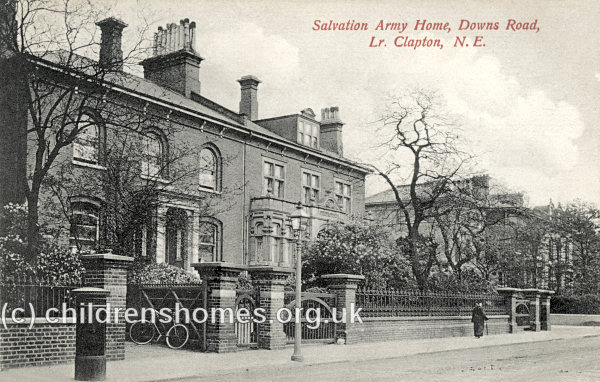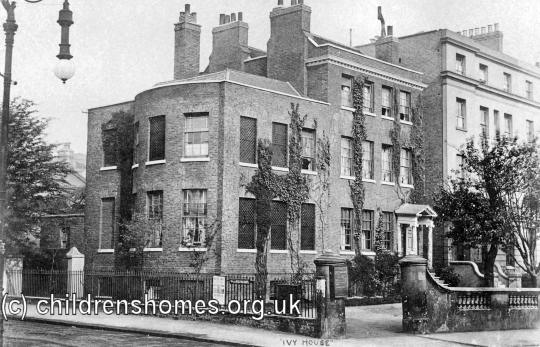Mother and Baby Homes
Until the latter part of the nineteenth century, virtually the only form of institutional accommodation for single mothers and their babies was the workhouse. Although various Magdalen Homes existed for the reform and rescue of 'fallen' women, these institutions did not provide accommodation for babies other than in the very short-term. Inmates who had babies were expected to place them with relatives or friends, pay for them to be fostered, or arrange their informal adoption. Growing concern about the plight of such women, and the conditions in which their infants would have to be raised, resulted in the gradual establishment of alternative types of home so that mothers could keep their babies with them, without suffering the harsh regime of the workhouse, where single mothers were often stigmatized. There was also a hope that the homes would strengthen the bond between a mother and her baby that might otherwise be lost if it was fostered.
One of the earliest of these new institutions was the 'Refuge for Deserted Mothers and Home for their Illegitimate Infants', opened in London in 1864 by Mrs Jane Dean Main, with the support of the Female Mission to the Fallen, part of the Refuge and Reformatory Union. The establishment offered short-term care to the nursing mother and, at the end of this period, long-term to the child when the mother went out to work, usually in domestic service. The provision for child might include foster care, to which the mother was expected to contribute financially.
The majority of these early Mother and Baby Homes were run by groups with religious connections such as the Salvation Army, the Church Army, and the Ladies' Association for the Care of Friendless Girls. As was the case with Magdalen Homes, the operators hoped that the time that the mother spent in the home, typically ranging from six weeks to three months, would allow her to receive religious instruction and moral guidance to prevent her falling into the same situation again. Some existing Magdalen Homes subsequently evolved into Mother and Baby Homes, so the distinction between the two categories of institution is often blurred, with the two sometimes being regarded as essentially the same.

Salvation Army Pre-confinement Home, 55 Downs Road, Hackney, c.1925 © Peter Higginbotham
Some establishments did not possess the necessary facilities for the delivery of the baby, which would then take place elsewhere such as the local workhouse infirmary, or one of the few pre-NHS maternity hospitals that admitted single mothers, such as Queen Charlotte's in London. Those institutions that had delivery facilities in addition to their pre- and post-confinement care were generally termed maternity homes. Those lacking delivery facilities were sometimes referred to as Before and After Care Homes. The term 'Mother and Baby Home' started to come into general use in the 1920s to describe any establishment providing accommodation for single mothers and their new child. Some institutions also provided accommodation in the form of hostels for pregnant working girls, and for single working mothers. Many Mother and Baby Homes restricted their intake to 'first offenders' — those undergoing their first pregnancy.

Ivy House, Hackney - a Salvation Army Maternity Hospital for single mothers, early 1900s. © Peter Higginbotham.
In Ireland, following its independence in 1921, a number of former workhouses housed unmarried mothers and their babies, either being dedicated to that role, as at Kilrush, Glenamaddy and Tuam, or acting as County Homes, which received a wider range of inmates. Specialist Mother and Baby Homes were also established by the Sacred Hearts religious order at Bessborough, Sean Ross and Castlepollard.
After 1930, when county and borough councils in England and Wales took over former workhouse sites, they also became increasingly involved in the provision of maternity care. Many workhouse became Public Assistance Institutions, accommodating unmarried mothers and their babies among a much wider range of inmates, or in the provision of maternity facilities in former workhouse infirmaries that had been converted to municipal hospitals.
Because of their large number, the catalogue of Mother and Baby Homes is split into a number of sections, listed below:
- Bedfordshire-Cumberland
- Derbyshire-Essex
- Gloucestershire-Kent
- Lancashire-Lincolnshire
- London — E/EC postal areas
- London — N/NW postal areas
- London — SE/SW postal areas
- London — W/WC postal areas
- Middlesex-Oxfordshire
- Shropshire-Sussex
- Warwickshire-Yorkshire
- Wales
- Channel Isles
- Scotland
- Northern Ireland
- Republic of Ireland
Except where indicated, this page () © Peter Higginbotham. Contents may not be reproduced without permission.


